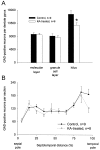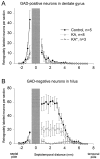Highly specific neuron loss preserves lateral inhibitory circuits in the dentate gyrus of kainate-induced epileptic rats
- PMID: 10531454
- PMCID: PMC6782907
- DOI: 10.1523/JNEUROSCI.19-21-09519.1999
Highly specific neuron loss preserves lateral inhibitory circuits in the dentate gyrus of kainate-induced epileptic rats
Abstract
Patients with temporal lobe epilepsy display neuron loss in the hilus of the dentate gyrus. This has been proposed to be epileptogenic by a variety of different mechanisms. The present study examines the specificity and extent of neuron loss in the dentate gyrus of kainate-treated rats, a model of temporal lobe epilepsy. Kainate-treated rats lose an average of 52% of their GAD-negative hilar neurons (putative mossy cells) and 13% of their GAD-positive cells (GABAergic interneurons) in the dentate gyrus. Interneuron loss is remarkably specific; 83% of the missing GAD-positive neurons are somatostatin-immunoreactive. Of the total neuron loss in the hilus, 97% is attributed to two cell types-mossy cells and somatostatinergic interneurons. The retrograde tracer wheat germ agglutinin (WGA)-apoHRP-gold was used to identify neurons with appropriate axon projections for generating lateral inhibition. Previously, it was shown that lateral inhibition between regions separated by 1 mm persists in the dentate gyrus of kainate-treated rats with hilar neuron loss. Retrogradely labeled GABAergic interneurons are found consistently in sections extending 1 mm septotemporally from the tracer injection site in control and kainate-treated rats. Retrogradely labeled putative mossy cells are found up to 4 mm from the injection site, but kainate-treated rats have fewer than controls, and in several kainate-treated rats virtually all of these cells are missing. These findings support hypotheses of temporal lobe epileptogenesis that involve mossy cell and somatostatinergic neuron loss and suggest that lateral inhibition in the dentate gyrus does not require mossy cells but, instead, may be generated directly by GABAergic interneurons.
Figures








References
-
- Amaral DG. A Golgi study of cell types in the hilar region of the hippocampus in the rat. J Comp Neurol. 1978;182:851–914. - PubMed
-
- Amaral DG, Price JL. An air pressure system for the injection of tracer substances into the brain. J Neurosci Methods. 1983;9:35–43. - PubMed
-
- Amaral DG, Witter MP. The three-dimensional organization of the hippocampal formation: a review of anatomical data. Neuroscience. 1989;31:571–591. - PubMed
-
- Babb TL, Brown WJ, Pretorius J, Davenport C, Lieb J, Crandall PH. Temporal lobe volumetric cell densities in temporal lobe epilepsy. Epilepsia. 1984;25:729–740. - PubMed
Publication types
MeSH terms
Substances
Grants and funding
LinkOut - more resources
Full Text Sources
